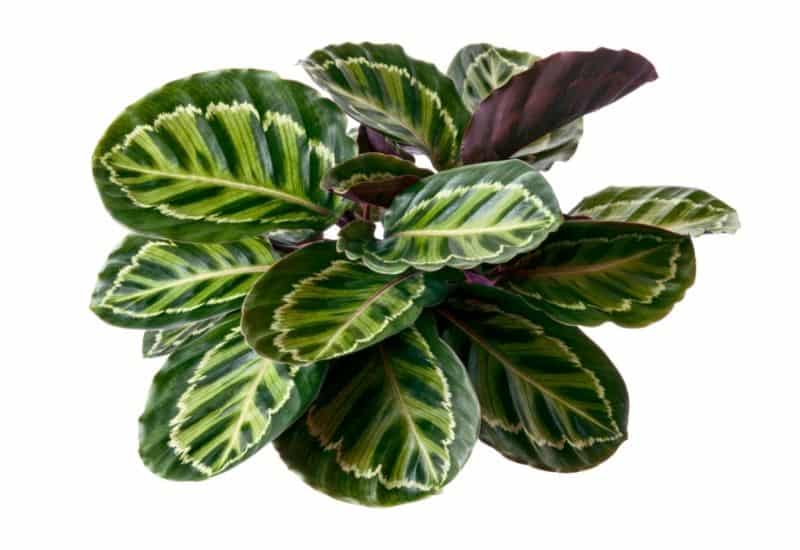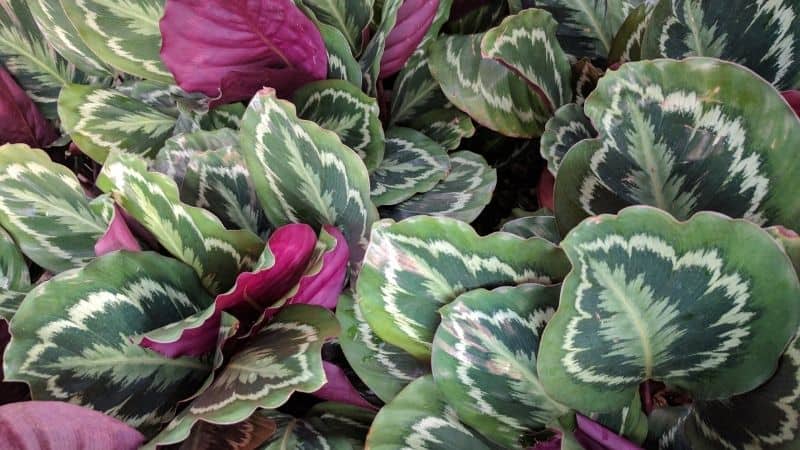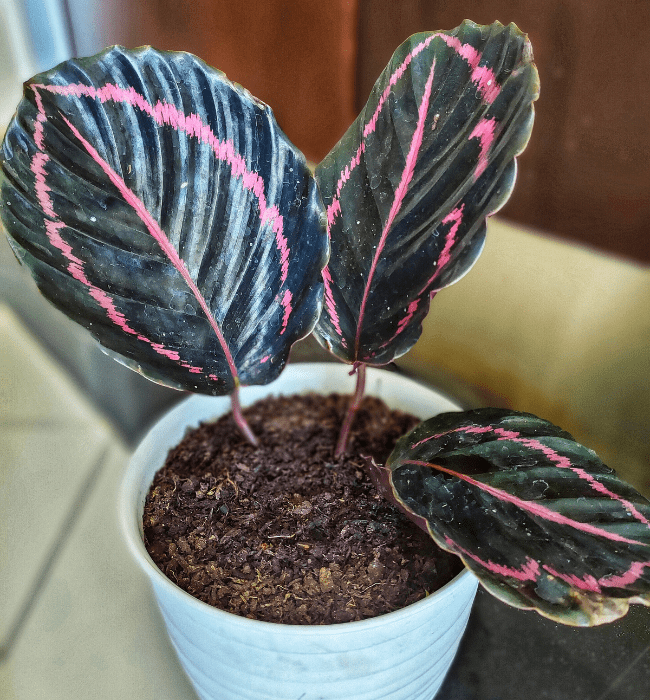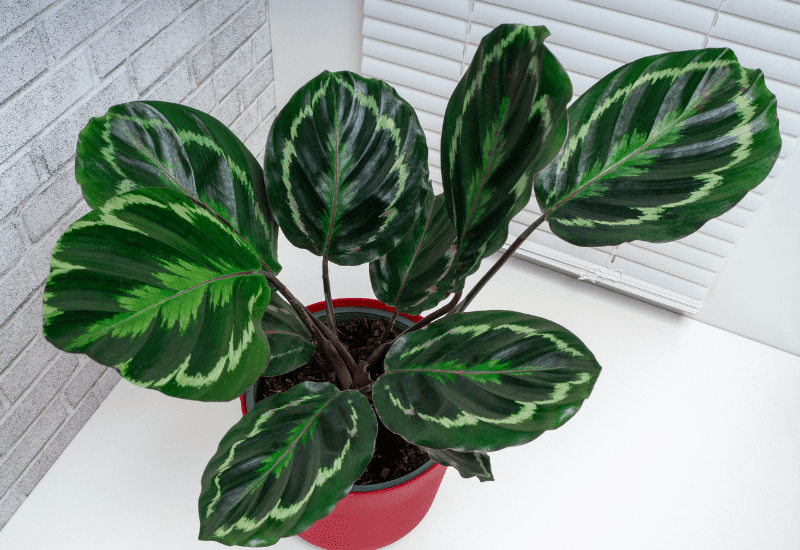Calathea roseopicta’s impressive rose-painted pallet is not just famous but a real game-changer to your garden. Many people love keeping Calathea for its tropical-looking mosaic leaves with purple-colored undersides.
But like other species of the Calathea, the roseopicta are easy to care for if you follow the proper care instructions. Here, we’ll examine in detail the plant care guide for Calathea roseopicta to keep it gorgeous and healthy.
Calathea Roseopicta Care Guide Overview
- How To Plant (when & where)
- How To Grow (staking, watering, fertilizing, humidity, mulching)
- How To Trim And Prune
- How To Pot And Repot
- How To Propagate (when & how)
- And Pests and Diseases, Plant Species, Companions, Toxicity
Characteristics
- Scientific Name: Goeppertia roseopicta (Calathea roseopicta)
- Common names: Rose-Painted Calathea
- Origin: Brazil, Colombia, Ecuador, and Peru
- Indoor or Outdoor Plant: Indoor plant
- Height and Structure: 50cm (20inch) maximum or more
- Flower Color: White and Purple
How to Plant the Calathea Roseopicta

The Calathea roseopicta is a native rain forest plant. As such, it requires indirect sunlight, humidity, and warmth to grow well. Don’t have these perfect conditions?
Worry less as it’s easier to create such conducive environments for your lovely plant. Below is a guide on how to plant the Calathea roseopicta in your home.
Planting Time
The Calathea roseopicta does not need any chilling time (cold treatment). It is best to plant them as soon as you get them. But if you can’t do that, then wait at least 3 to 4 weeks before planting.
If the plants stay in a greenhouse or inside your home for several days, acclimate them to the outdoor or indoor environment before planting.
Spacing
The best spacing for the Calathea roseopicta is 40*40cm (16′ * 16′). They will grow upright and cane-like in appearance.
If you want a full and bushy plant, provide ample vertical space or even let it sprawl down for a larger area. The usual distance between plants is about 6-10feet from a window.
It should face east, west, or north. Make sure it’s not within reach by sunlight. The room needs to be bright but free from intense light. Artificial lighting can be the best choice.
Lighting and Temperature
The Calathea roseopicta loves bright light! It will be withering if it doesn’t get any. Like most tropical plants, the Calathea roseopicta prefers indirect sunlight and partial shade.
Direct sunlight is also okay as long as you put the plant in a warm place (never cold). Make sure the temperature ranges between 64-750F (18 to 240C).
The plant will need the temperature in the house to be around this range for much of its life, especially when it’s grown indoors. Never plant this plant in places with temperatures below 600F (150C) as it doesn’t grow well in cold conditions.
Potting Mix and Bedding
An ideal potting mix will be peat-based soil with plenty of perlites. Ensure the components are not more than 30% drainage, as a slow drainage rate will promote root rot.
You might also want to add fertilizer to speed up the roots’ growth. You may also consider using soil-less or cactus potting mix.
Watering
The Calathea roseopicta likes to have evenly moist but not soggy soil. Water it every day with lukewarm water until the leaves look slightly shiny. The plant will need about 25% of its original volume of water.
Less frequent watering is ideal, provided the soil isn’t dry and hard to touch (again, not soggy). Generally, ensure the top half-inch of the soil is dry before you can rewater the plant.
That’s because overwatering the plant may cause root rot. Its rhizome structure is prone to damage by rot pathogens in wet conditions. Don’t create a regular watering schedule. Instead, watch the soil vigilantly.
Soil Requirements
The soil must have fast-draining abilities and an excellent aerating structure to ensure the roots receive adequate oxygen. Besides, the soil must stay rainforest-damp but not soggy.
How to Grow the Calathea Roseopicta

Growth habits
The Calathea roseopicta is a bushy plant. It’s best to prune it occasionally to keep its shape, although not advisable for beginners because the leaves have thorns underneath.
Staking
The Calathea roseopicta has stems that are weakly attached to the soil. It doesn’t require staking, but if it is done, use sticks about 50cm (20 inches) long and tie them gently on both sides of the stem.
Fertilizing
The Calathea roseopicta produces flowers that are held on short stems. You may consider fertilizing it, but not too much, as it is possible to burn the roots.
Uptake may also be slow, so you might want to dissolve the fertilizer in water first before giving them to your plant.
You can fertilize the plant using a well-balanced diluted solution every two weeks from April to early October.
Types of Fertilizers to use:
• Synthetic fertilizers
These fertilizers often work well with the plant. They’re also cost-effective to use. But you should dilute these fertilizers in the ratio of 1/4: 1/2 of the stated dose.
The plant’s roots are delicate and will burn easily from the fertilizer remains. So never use synthetic fertilizers as they can burn the roots to death.
Avoid high doses of ammonium nitrate (28% solution) if possible too.
• Organic fertilizers
Organic fertilizers increase soil fertility naturally by using natural products such as bone meal, worm castings, fish emulsion, etc. The good thing with organic fertilizers is that they are safe for your plant and boost soil fertility.
Humidity

The Calathea roseopicta prefers high humidity levels of at least 70%. However, the plant won’t tolerate humidity less than 40%. You can easily recreate this by having them under a humidifier, or you may also mist them with water every day.
If the leaves start wilting, then there is not enough humidity. Place the pot on top of pebbles filled with water to increase its humidity.
Mulching
Any mulch is good for the Calathea roseopicta. It keeps weeds at bay and helps retain moisture. Just make sure it’s not too thick, so you can still see your plant’s leaves!
You can use manure or compost instead of mulching to fertilize your plant while making it look nice too.
Trimming and Pruning
The Calathea roseopicta never grows too tall. It remains at about 20-30cm (8-12 inches). But you can still trim it to make it bushier or shorter if desired. As for pruning, it’s best to cut away dead leaves and stems.
Doing so helps get rid of habitat for pests and pathogens. It’ll also help you spot the availability of pests or other sorts of problems that may affect the plant’s health.
ital Tips:
• Use sharp shears or scissors to make the cuts
• Sterilize the tools before and after every use (wipe the cutting blades using isopropyl alcohol
• Trim the plant’s stalks at the soil level
• Cut off the dead leaves or drying matter
Propagation
The Calathea roseopicta is a very easy plant to propagate. Pull off its leaves or use a sharp, sterilized blade to cut them into 2-5cm (1-2 inches) sections.
Then put them in moist soil with a humidity level of 70% or more. Keep the soil moist and in a warm place to stimulate root growth.
The Calathea roseopicta can be propagated via cutting. Cut it at the base using a sharp, sterilized blade.
Make sure not to damage any major veins or arteries on the stem, or it will die off after some time. Get some potting mix specially made for cactus and put the cutting in it.
Keep the soil moist at all times, but never too wet to avoid rotting or fungal growth.
Divide and Transplant
The best way to propagate the Calathea roseopicta is by dividing it. When it has grown too big, you can use a sharp, sterilized blade to cut through the middle of the plant horizontally.
This will make two plants with roots on each side. You may pot them in newly-made rows or transfer any offsets you have to new pots.
Pests and Problems
The common pests for Calathea roseopicta are spider mites. It is a tiny pest that feeds on the surface of leaves and can make Calathea look unsightly.
If you think your plant has been exposed to spider mites, it’s best to carefully remove any affected parts and rinse them in clean water coupled with mild soap or insecticide.
Other pests include aphids, mealybugs, and scale. You can control these pests using insecticides or soaps.
Aside from this, the Calathea roseopicta has no serious other problems. It’s best to keep it away from direct sunlight and sudden temperature changes.
Diseases
If the leaves are wilting or have brown spots, it has probably been exposed to excessive moisture or cold temperatures. If this is the case, you can cut away affected parts and dry the rest for a few days.
In case there’s black spotting on leaves, then it could be caused by too much humidity. It could also mean that the soil is too wet or that you have been watering it excessively.
If there are brown spots on leaves, it might be caused by sudden temperature changes or exposure to direct sunlight. In this case, make sure to offer some shade and raise humidity levels to avoid further damage.
Pot and Repotting

If you are growing the Calathea roseopicta in soil, it’s best to use a pot that has holes or slots on its bottom. This helps keep the soil moisture at optimum levels. Make sure not to overwater your plant as this can rot its roots.
As for repotting, do it every 1-2 years. It does not need frequent repotting, though.
Growth Cycle
The Calathea roseopicta is slow to grow, but it’s not difficult. To propagate the plant, cut off a stalk with 5 leaves attached (which will root) and leave it in water until the roots are formed.
Transplant when the larvae have grown enough for sturdy support. The Calathea roseopicta will need 2 months to grow (though the time may vary depending on the temperature and humidity levels).
Flowering and Pollinating
The Calathea roseopicta blooms once a year, sometimes twice if the plant is kept well and regularly watered. The flowers are tubular and bright orange/yellow, with a velvety texture.
It has a strong scent, but it has been reported as sweet or having a hint of vanilla. The Calathea roseopicta blooms during the spring season (usually late summer in places like New York).
They also require pollination from specific insects. The inflorescences will directly open to the pollinators and remain closed to other insects.
Calathea Roseopicta Species
The plant exists in various subspecies, with each having different leaf colors and or patterns. Some of the common species include:
Corona: The leaves have a light yellow-green edge with contrasting colors in the center. The veins are dotted with brown spots.
Fulgens: The leaves are cream-colored with green edges, while its hybrids have maroon or purple veins that fade into the leaf’s background color when grown under intense lighting.
‘Cynthia’ – This subspecies has leaves with green edges and veins.
‘Variegata’ – The leaf’s center area is white, surrounded by a wide flooded margin of yellow or greenish-yellow.
‘Dottie’ – The leaves are light to light green with very shiny spots at the edge.
‘Cambodia’ – The leaf’s center is a dark red that fades into pale green towards its edges.
Companions
The Calathea roseopicta grows well with the Sansevieria and other succulents. It does not have any serious requirements aside from being placed in a warm spot with minimal light.
Make sure that it’s never exposed to direct sunlight, as this will cause its leaves to curl up. If you want to grow the plant in soil, good choices are cactus or orchid potting mix. You can also use a soilless substrate for this.
What are good neighbors?
The Calathea roseopicta does not have a lot of serious predators, though mealybugs can attack it. Here are some plants which you can grow with the Calathea roseopicta:
Aloe Vera – The gel that coats its leaves will help prevent infestations from insects and mites.
Cicada – The bright colors of this flower will complement the Calathea roseopicta’s leaves.
Dierama – This fast-growing plant can grow up to 10 inches per week. It’s a good companion for a propagation medium or a ground cover for a slope.
Maranta: This succulent is also known as Prayer Plant, so it can also help grow small shoots of the Calathea roseopicta.
Cuphea: This plant is a fast-growing perennial with bright red flowers that complement Calathea’s leaves.
Toxicity
Is Calathae roseopicta toxic?
The Calathea roseopicta may not be toxic, but you can’t eat it if you try. If ingested, the leaves of the Calathea roseopicta bear no serious effects on humans.
Some people may have an allergic reaction to its pollen, though. Contact allergens are also present in its sap.
Is the Calathea Roseopicta Toxic to Pets?
No studies have ever been done on whether or not the Calathea roseopicta is toxic to pets. But based on its appearance, this plant does is not toxic to your pets.
Calathea roseopicta is a beautiful and interesting plant. It looks fantastic as part of your landscaping and can also be used indoors as an ornamental plant.
If you want to grow this, make sure that it’s not exposed to direct sunlight or very little light. Keep its soil moist during the summer, but reduce watering during winter.


